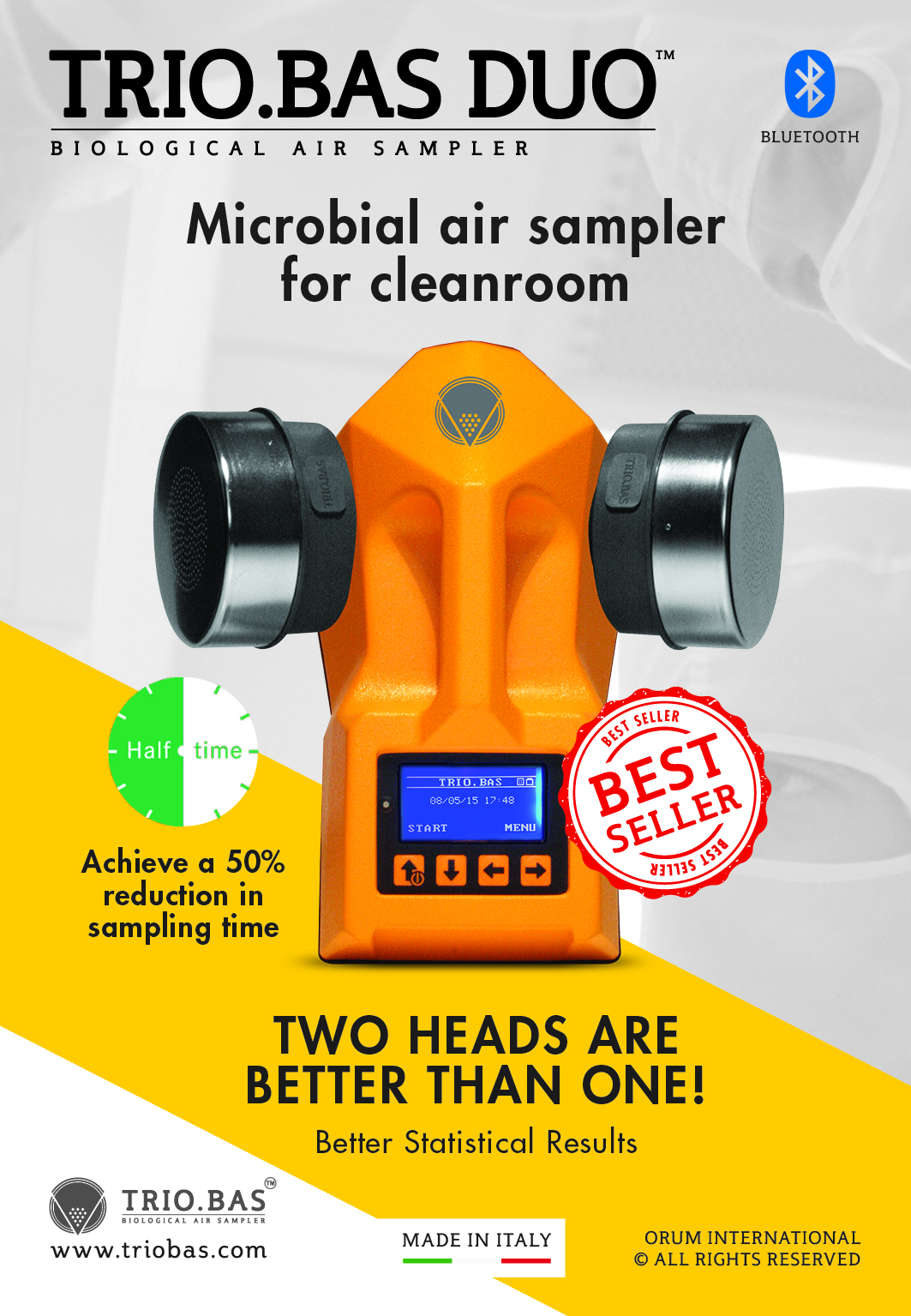Application Note – Bioaerosol N.4 – Staff training for food handlers

Introduction
The importance of mantaining good hygiene is well known to dairy and food quality control personnel, but it can be difficult to impress on general plant workers the importance of good manufacturing practice (G.M.P.).
Increasing emphasis on general hygiene conditions will allow manufacturing of products with longer shelf-life, lower rejection rates, fewer complaints from customers, and higher production rates.
Therefore, G.M.P. is financially convenient, and training of all staff will help in obtaining the required awareness to improve and maintain the quality of the working environment. The proposed simple experiments in this article are suggestions for a general training program to illustrate the causes of microbiological spoilage of food and to demonstrate the method by which airborne and surface bacteria are spread.
Materials and methods
- Microbiological air sampler
- Contact plate with Plate Count Agar and other selective media
The method is reported in the producer’s documentation.
Practical experiment for food handlers
- Experiment 1 – Surface counts of utensils and environment
Purpose: To prove why all utensils and surfaces in contact with food must be clean.
Action: Ask the workers to press a Contact Agar Plate (PCA) onto the surface of blades, propellers, mixers, tables, and shelves before and after cleaning. At the end of incubation time, the difference in number of micro-organisms between the before and after plates will show the staff the adequacy of cleaning procedures.
- Experiment 2 – Cleaning of surface before application of disinfectant
Purpose: To prove why surfaces must be first washed and rinsed before applying disinfectant.
Action: Ask the operator to press the Contact Agar Plate (PCA) against a table, wall, floor, and other surfaces disinfected with a sanitizer (e.g. chlorine) after proper washing and rinsing. Repeat the same method on similar surfaces disinfected with a sanitizer but without the washing and rinsing steps.
At the end of incubation time, the higher number of micro-organisms on disinfected surfaces without the washing and rinsing steps will show the reason for the correct sanitizing method.
- Experiment 3 – Importance of personal hygiene using the toilet
Purpose: To demonstrate the importance of washing your hands after visiting the toilet.
Action: Ask the worker to print his finger on the surface of a Contact Agar Plate (PCA) before and after the use of the toilet (with and without hand washing).
At the end of incubation time, the difference in number of micro-organism between the plates will show the reason for correct hand washing.
- Experiment 4 – Effect of aerosol disinfectant
Purpose: To demonstrate the effectiveness of aerosol disinfection in a closed environment (cooling room, refrigerators, ripening room, filling and packing room ,etc.)
Action: Air samplings with air sampler loaded with a Contact Agar Plate (PCA) are made before and after
area cleaning and disinfection. At the end of each sampling time, collect the plate, transfer it to an incubator, and incubate at 32°C for 48 hours to obtain CFU/m3 . A definite decrease in numbers of microbes per cubic meter of air in the disinfected area will illustrate the effectiveness of correct aerosol disinfection in terms of concentration, etc.
- Experiment 5 – Reduction of mold spores by fungicide fumigation
Purpose: To demonstrate the fungicide activity of fumigation procedures.
Action: Air samplings with air sampler are made before and after area cleaning and treatment.
Be sure to use the correct size based on the room volume. Load the air sampler unit with a Contact Agar Plate containing rose Bengal /chloramphenicol agar. At the end of sampling time, collect the plate, transfer it to an incubator (or leave at room temperature), and incubate at about 25° C for 72 hours to obtain CFU/m3. The absence or a definite decrease in the number of molds per cubic meter of air in the treated area will illustrate the action of the fumigant.
- Experiment 6 – Contamination of air by dry sweeping versus wet sweeping
Purpose: To prove how dry sweeping of floors is a high source of contamination compared with wet sweeping.
Action: Air sampling with portable “SAS” loaded with a Contact Agar Plate (PCA) are made immediately after dry sweeping and wet sweeping of floors. At the end of each sampling time, collect the plate, transfer it to an incubator, and incubate at 32° C for 48 hours to obtain CFU/m3. The difference in number of micro-organisms between the plates used for dry sweeping and wet sweeping on the reduction of contamination.
- Experiment 7 – Effect of concentration of aerosol disinfectant
Purpose: To check that aerosol disinfectant has been used at correct concentration and in the correct way.
Action: Air sampling with the air sampler loaded with a Contact Agar Plate (PCA) are made with different disinfectant (or with the same disinfectant at different concentrations). At the end of each sampling time, collect the plate, transfer it to the incubator, and incubate at 32° C for 48 hours. Count the Colony Forming Units per plate and relate to number per cubic meter of air. The lower the number of organisms the higher the suitability of the disinfectant or the concentration at which it was applied.
- Experiment 8 – Microbial load in air of specialized rooms
Purpose: Evaluation of the air hygiene level in critical environments (e.g. sterile filling and packaging of yogurt, packing of special surface soft cheese, etc.).
Action: Air sampling can be made with “SAS”. After completion of preliminary test, it is recommended that at least 30 samples be obtained for each definable area, so that a more significant interpretation can be made from the results. The number of CFU/m3 of air sampled should be plotted on graph paper. This immediately gives an indication of the level of hygiene in the area sampled.
The highest and lowest results are excluded and then the mean value for the group of tests is calculated and drawn on the graph.
This will indicate the overall pattern and will be located within one of the classes. The reliability and accuracy of the results will be shown by the degree of scatter. If some values are shown in classes either above or below the actual class, then the degree of air hygiene control in not sufficient.
Once the classification of the area has been made, then repeated sampling is required to monitor hygiene level.
- Experiment 9 – Evaluation of airborne phage
Purpose: To check the presence of airborne phages in processing rooms as indicators of airborne contamination.
Action: Prepare Contact Agar Plates (PCA) with medium swabbed with an appropriate micro-organism sensitive to the phage. Take air samples with the air sampler, incubate, and observe for “no growth” plaques. The presence of plaques is a presumptive indication of phage contamination in the air.
- Experiment 10 – Identification of airborne microbes
Purpose: Identification of different airborne organisms using selective media
Action: Air sampling with portable “SAS” are made with Contact Agar Plates containing different selective media. The incubation times and temperatures will be a function of the media used. The identification of micro-organisms will be done by traditional microbiological tests.
- Experiment 11 – Effect of surface brushing of cheese on aero-microbiology
Purpose: To demonstrate how surface brushing of ripened hard cheese made inside a ripening room is a source of further mold contamination.
Action: Air sampling with portable “SAS” unit are made before and after cheese brushing.
Load the air sampler unit with a Contact Agar Plate containing rose Bengal /chloramphenicol agar. At the end of each sampling time, collect the plate, transfer it to an incubator (or leave at room temperature), and incubate at about 25° C for 72 hours to obtain CFU
of mold/m3. A definitive increase of molds in the area after cheese brushing will illustrate the risk of this action.
Conclusion
To obtain the best results in the application of hygiene by food and dairy staff, it is imperative to have their goodwill and involvement.
They must understand the reason for what they are doing and why specific method are requested. We think that these simple experiments can contribute to making the world of micro-organisms less of a mystery to lay staff who will be involved in general food and dairy production routines and to help them understand the reasons for specific hygiene procedures.
References
Al-Dagal, M. and D.Y.C. Fung. 1990. Aeromicrobiology: A Review. CRC Press.
Favero. M.S, J.J. McDade,J.A. Robertson, R.K.Hoffman, and R.W.Edward. 1968. Microbiological sampling of surfaces. J. Appl. Bacteriol. 31:336-343.
Kang. Y.J. Frank. 1989. Biological aerosols: A review of airborne contamination and its measurement in dairy processing plants. J.
Food Protect. 52:512-524.
Lee, J.Y. and D.Y.C. Fund. 1986. Method for sampling meat surfaces. J.Environ. Health 48(4): 200-205.

















